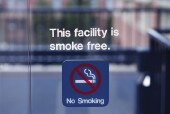
TUESDAY, Jan. 12 (HealthDay News) — The U.S. government took some important steps last year to prevent tobacco-related disease and death, but most states got a failing grade and 10 made alarming cuts to their tobacco control programs, a new report shows.
According to the Tobacco Control 2009 report, released Tuesday by the American Lung Association, the important actions taken by the federal government included giving authority to the U.S. Food and Drug Administration to regulate tobacco products and more than doubling the federal cigarette tax, from 39 cents to $1.01 per pack of 20 cigarettes.
The report card gave the following grades to the federal government:
- An “A” for regulation of tobacco products. The new powers given to the FDA have tremendous potential to reduce tobacco-related death and disease, it said.
- A “D” for the increase in the cigarette tax to fund the Children’s Health Insurance Program. While the tax increase has persuaded many smokers to try to quit, the new tax still falls short of the “A” standard of $2.68 per pack.
- An “F” for smoking cessation. The federal government doesn’t help smokers quit — an effort that would save lives and money, the report said.
- A “D” for failure to ratify the international Framework Convention on Tobacco Control, which has been ratified by 168 nations representing 86 percent of the world’s population. Failure to ratify the tobacco control treaty means the United States can’t participate in negotiations to implement and enforce it.
“Our leaders in Washington have made a strong start in confronting the tobacco epidemic and taking steps that ultimately will save millions of lives and hundreds of billions of dollars for the American economy. Ending the epidemic, however, will require more hard work,” Charles D. Connor, president and CEO of the American Lung Association, said in a news release from the association.
But he added that “political leaders in the states need to stand up to the tobacco industry and enact policies proven to reduce the devastating death and disease caused by tobacco use.”
In an effort to boost revenues to help cope with record deficits, 14 states and the District of Columbia raised cigarette taxes in 2009. However, 10 states and the District of Columbia sharply reduced funding for tobacco control and prevention programs.
For example, Wisconsin increased its cigarette tax by 75 cents but cut funding for tobacco prevention and cessation programs by more than half. New Hampshire increased its cigarette tax by 45 cents but didn’t spend a single state dollar on tobacco prevention and cessation programs, the lung association said.
The report also found a dramatic slowing in the pace of states passing comprehensive smoke-free air laws.
“Increasing tobacco taxes and requiring smoke-free workplaces are two important steps in reducing the leading cause of preventable death in the United States. But that is still not enough. Comprehensive cessation programs must also be made available to support them in quitting,” Mary H. Partridge, chair of the national board of the lung association, said in the news release.
No states received straight “As” on the association’s report card, but six states received all “Fs” — Alabama, Kentucky, Missouri, South Carolina, Virginia and West Virginia. Here’s what the report card said about the states and the District of Columbia:
- State Cigarette Taxes: Only four states received an “A” by imposing taxes of $2.68 or more. Among states that raised cigarette taxes, three (Hawaii, Pennsylvania, Wisconsin) and the District of Columbia made cuts of 25 percent or more to their funding of tobacco control programs.
- Smoke-free Air: Only three states (Michigan, South Dakota, Wisconsin) met the lung association’s Smokefree Challenge in 2009 by passing strong smoke-free laws. That’s better than the two states that met the challenge in 2008 but far less than 2006-07, when 16 states and the District of Columbia met the challenge. The report card gave an “A” to 22 states and the District of Columbia for smoke-free air policies in 2009.
- Tobacco Prevention and Control Programs: Only two states (Alaska and North Dakota) received an “A” in this category. Their funding of tobacco control and prevention programs was 80 percent or more of the level recommended by the U.S. Centers for Disease Control and Prevention. The District of Columbia and 41 states received an “F” for spending less than 50 percent of the CDC-recommended levels. The District of Columbia and the following 10 states reduced spending by 25 percent or more: Colorado, Hawaii, Indiana, Maryland, Massachusetts, New York, Pennsylvania, Tennessee, Washington and Wisconsin.
- Cessation Treatments: No state received an “A” in this category, while 31 states received an “F” for their failure to offer comprehensive tobacco cessation treatments to Medicaid recipients and state employees.
The American Medical Association (AMA) said it was “disappointed” by the failing grades for tobacco prevention and smoking cessation programs.
“The AMA strongly supports smoke-free laws, efforts to prevent youth smoking and educational programs that focus on quitting. By funding tobacco prevention and cessation programs, states have the ability to save on long-term health care costs and, most importantly, save lives,” said Justin Mahida, an AMA board member, in a statement.
Smoking-related disease is the leading preventable cause of death in the United States, killing more than 393,000 people each year and costing the economy more than $193 billion. Another 50,000 Americans die from exposure to secondhand smoke.
“The failure of the federal government and each state government to get all “A” grades for enacting strong and effective tobacco control laws comes at a critical time,” the lung association said in its news release. “Tobacco control policies are extraordinarily popular. But the tobacco industry is not letting up on its aggressive marketing and promotion strategies to spur increased smoking. Until elected officials overcome their fears of standing up to the tobacco industry, hundreds of thousands of lives will be tragically lost and billions of dollars will continue to be wasted.”
More information
The U.S. Centers for Disease Control and Prevention has more about the health effects of tobacco.

